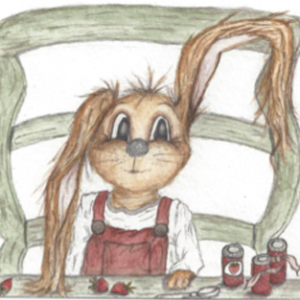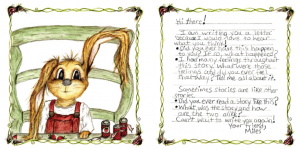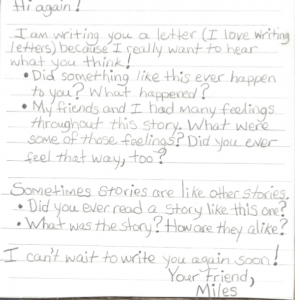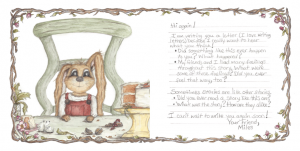Why does Miles ask his readers to make connections?
By Jamie Ruthenberg

At the end of every story in the Miles Educational Series, Miles hand writes a letter to his readers—something you don’t usually see in a children’s book! To have the main character “talk” to his readers about the story itself is a new experience for many children. Why does he write a letter to his readers?
As the author of the series, there are a couple of reasons why I have Miles do this. For one, if I were a child reading a letter from Miles, it would bring him to life even more. For Miles to suddenly leave the story to talk to me about what I just read makes him seem real, and it makes me pretty special!

There is an educational purpose to him doing this, as well.
Miles asks his readers questions like,
“Did somcething like this ever happen to you? What happened?” and
“Did you ever read a story like this one? What was the story and how are they alike?”
Miles asks questions that encourage readers to make what educators call text connections. Text connections are fancy ways of describing what happens when a reader makes a connection to a story through their own personal experiences, or makes a connection to another similar story or to similar events in the world around them. Personal connections are called text-to-self connections. Text-to-text and text-to-world are the technical terms for the latter two.

As Tracy Ostwald-Kowald explains in her educational article “Meaningful Connections Increases Reading Comprehension,”
“….when young people read books that connect to personal experience, other books they’ve read, or something going on in the world, the material in those books makes more sense.”
Simply said, when a reader makes these kinds of connections to a story, he or she is not only more likely to understand the information just read. The information is also more likely to “stick” in the mind in terms of long term memory.
Think about it. In the past, when you identified with something you read, you remembered it, didn’t you? Pretty simple concept, with powerful impact, especially when informing young minds.

So, yes, I have Miles “speak” to the children that love him to bring him to life even more in their hearts. At the very same time, my goal is to introduce and encourage children to practice making text connections in the hopes that they will utilize this learning strategy throughout there lives.
Making reading a personal and meaningful experience at a young age can have a powerful affect on a child’s outlook on learning, an outlook that he or she may possibly carry into adulthood. At the very least, that is my hope.
For more information about text connections and reading comprehension, please read Tracy Ostwald-Kowald’s wonderful article “Meaningful Connections Increase Reading Comprehension” at http://www.connectionsacademy.com/blog/posts/2016-03-29/Meaningful-Connections-Increases-Reading-Comprehension.aspx
JR

